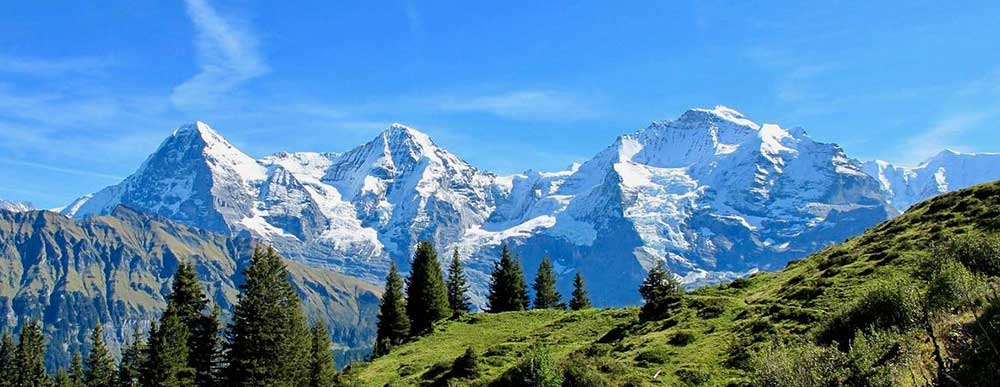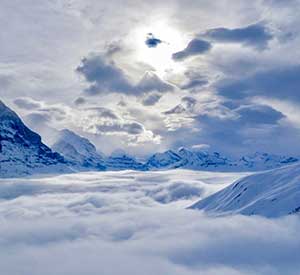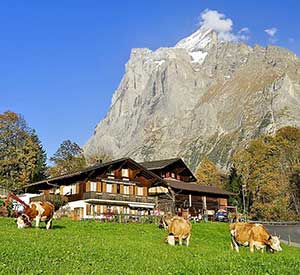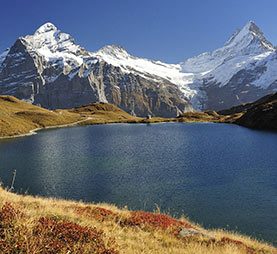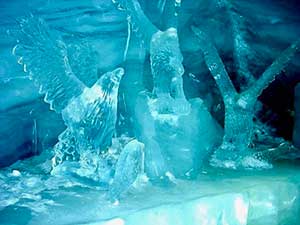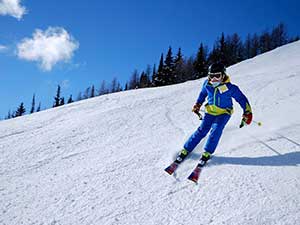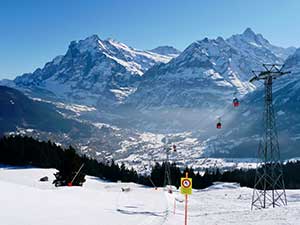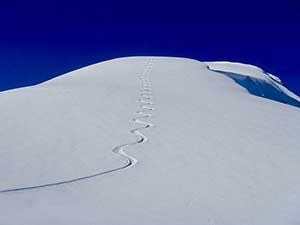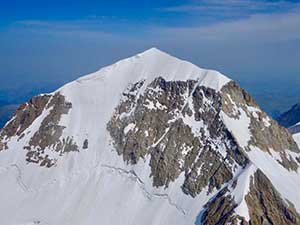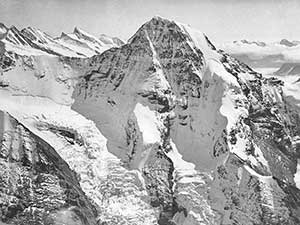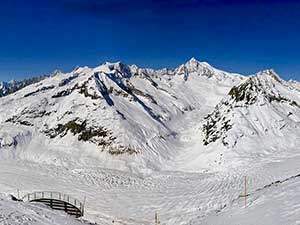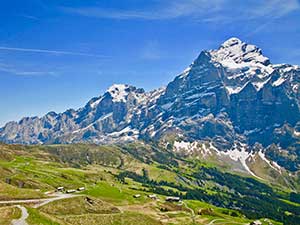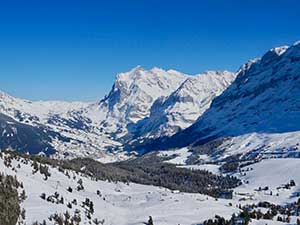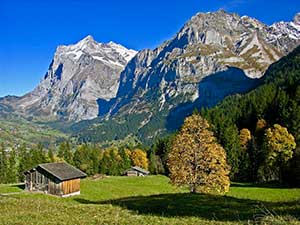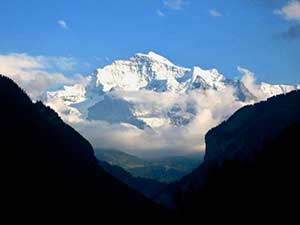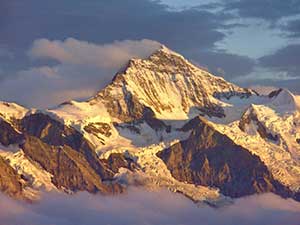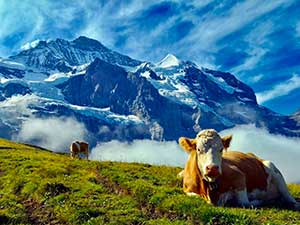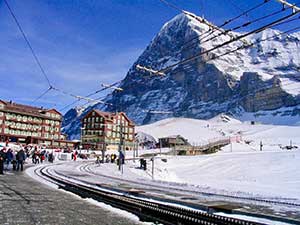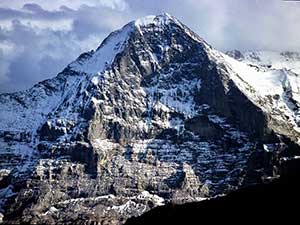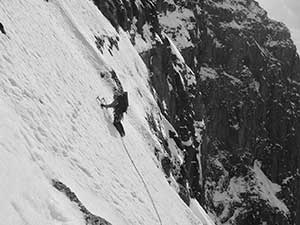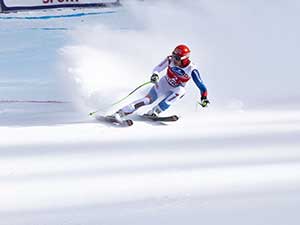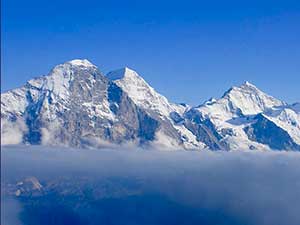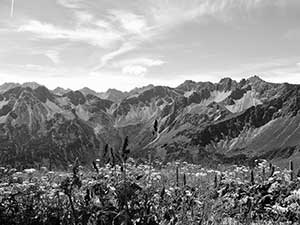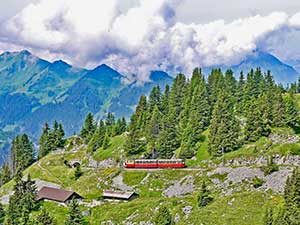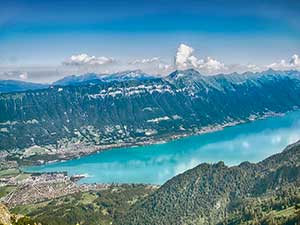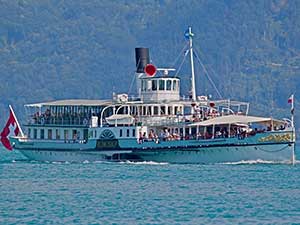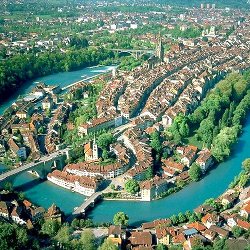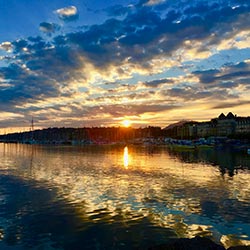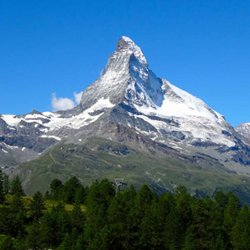Grindelwald, located at the heart of the Bernese Alps, is one of the three main Alpine centres (the others being Zermatt and Chamonix).
Boasting the Eiger, Monch and Jungfrau mountains, and the Jungfraujoch railway, Grindelwald is a favourite destination for those who love the mountains.
At an altitude of 1034 metres, and with a history dating back to 1146, Grindelwald is surrounded by lush green pastures and towered over by the 3970 metre Eiger. The near-vertical north face of that mountain has obsessed mountaineers for centuries, featuring in the films Eiger Sanction (starring Clint Eastwood) and Nordwand, and being one of the Alps' Great North Faces.
The Eiger marks the start of a ridge which takes in the Monch (4107 metres) and Jungfrau (4158 metres). Visitors can get close to the snow-capped peaks by taking the Jungfraubahn from the Kleine Scheidegg to the Jungfraujoch. This 9-kilometre journey, largely through tunnels blasted into the Eiger's north face, whisks visitors up to an ear-popping 3454 metres.
Grindelwald also offers fantastic day hikes, world-class skiing, and great accommodation, cuisine and hospitality. It is also within easy reach of Switzerland's capital, Bern, which is a good rainy day attraction.
Last updated: Dec 2019.
1. The Jungfrau Railway (aka the Jungfraubahn)
Built between 1896 and 1912, the Jungfraubahn is a cog railway that takes passengers from the Kleine Schiedegg (2061 metres) to the Jungfraujoch (3454 metres).
The 9.3 kilometre, 50-minute journey is largely underground, passing through tunnels blasted into the north face of the Eiger (3970 metres).
The journey includes short stops at Eigerwand (2865 metres), in the middle of the Eiger's north face, and Eismeer (3160 metres), on the Eiger's west ridge, to take in the majesty of the Eiger at close quarters through observation windows.
The Top of Europe
Upon arrival at the Junfraujoch—called the Top of Europe by the company operating the railway—visitors will notice the views and the altitude (with physical exertion far harder than in the valley).
Editor's tip ...
The best place to take in the mountains is the Sphinx Terrace (3571 metres, reached using Switzerland's fastest lift). The indoor and outdoor viewing platforms offer unrivalled views of the Jungfrau (4158 metres, pictured), the Monch (4107 metres) and the numerous surrounding peaks and glaciers.
Those with boots and warm clothing can walk along a pre-prepared snow track to the Monchsjochhutte (3658 metres), an alpine hut perched on the side on the Monch; this 2 kilometre walk passes by the Snow Fun Park, offering sledging, skiing, snowboarding and a zip-line. MAP
Other things to see
Next on the list of things to do is the Alpine Sensation exhibition, which gives information about the Adolf Guyer-Zeller's audacious plan to build the Jungfraubahn and the dangers faced by the workers who turned it into reality. This leads to the Ice Palace (Eispalast), a 1000 square metre igloo with numerous niches, passageways and ice sculptures.
Complete your trip by stepping onto the snowy Plateau, above the impressive Jungfraufirn part of the Aletsch Glacier (the largest in the Alps), and take in the mountain views one last time before the return trip.
£$€¥ A ticket to the Top of the World is not cheap! A return adult fare from Grindelwald costs up to CHF167-217 (Dec 2019), depending on the season. Half fare cards accepted.
2. The Skiing
Grindelwald is a fairly low ski resort—its highest lift is at 2,486 metres—with predominantly intermediate terrain, some terrifying advanced ground and breathtaking scenery.
The resort's 213 kilometres of pistes are found in three areas: around 50 kms in the First area towards to east of Grindelwald; 100 kms at the base of the Eiger (together with 30 kms of toboggan runs); and the remainder at Murren (accessed by rail or coach). There are three nursery areas, 24 beginner pistes (blue runs), 36 intermediate runs (red runs) and 12 advanced routes (black runs).
Terrain for all levels
Beginners looking to gain confidence will enjoy a number of 'slow slopes', with a 30 kilometre per hour speed limit. For intermediate skiers, the highlights are the 8 kilometre run from Oberjoch down to Grindelwald and the powder slopes of the Eiger glacier. MAP
Advanced skiers can try the world-famous Lauberhorn world cup piste, the challenging Black Rock run from the base of the Eiger, or Murren's near-vertical Kanonenrohr (meaning gun barrel). There is also nightskiing in the BodmiArena on Tuesdays and Fridays from 7pm-10pm.
Rock out!
The season is brought to a close by the Snowpenair concert, held at the Kleine Sheidegg. The next concert, the 23rd edition of the event, takes place on 4/5 April 2020 with acts like Sunrise Avenue, Helene Fischer and Crazy Mofos. Headline acts in past years have included James Morrison (2019), Amy Macdonald (2018), Deep Purple (2014), Roxette (2013) and Bryan Adams (2012).
Boarders
For boarders, First is the place to head. There is a warm-up park on the Oberjoch, the White Elements freestyle park, a superpipe at Shrekford and a terrain park at Bargelegg. There are also 20 kilometres of cross-country tracks, starting at Grund.
when? Grindelwald's ski season runs from early December to mid-April.
£$€¥ A 6-day peak pass costs CHF309 (Dec 2019).
3. The Mönch
The 4,107 m (13,474 ft) Mönch is found between the Jungfrau to the west and the Eiger to the east.
It was first summitted in 1857 by the famous mountaineer Christian Almer (whose other first ascents include the Eiger and the Aiguille Verte on Mont Blanc), Christian and Ulrich Kaufmann and Sigismund Porges.
Found at the heart of the Berner Oberland, the picture-perfect Mönch/Jungfrau/Eiger triumvirate can be seen for hundreds of miles. The north face of the Mönch, with a prominence of almost 600 metres leading down to the Eiger glacier (pictured), is its most impressive aspect.
Climbing the Monch
For mountaineers, the Mönch is a perfect introduction to the region. Graded PD (peu difficile), the ascent of the normal south-east ridge can be completed in around 3-4 hours, initially on rock and then on snow ridges.
Whilst a short day in terms of alpine ascents, caution is needed because the summit ridge is narrow and exposed. The descent takes around 2 hours. For those after a more difficult ascent, the west ridge is steeper and more exposed and the Nollen ridge on the north-west spur presents considerable ice challenges.
The Monchjochhutte
Many climbers overnight at the Mönchjochhütte—a well-maintained mountain hut offering hearty mountain grub and accommodation in 12-person dorms—and tackle the Jungfrau, Walcherhorn or Gross Fiescherhorn the next day. At 3,650 metres, the Mönchjochhütte is the highest Swiss alpine hut.
where? The Mönch is accessed from the Jungfrau railway station. Take the east exit towards the Mönchjochhütte and walk about 1 kilometre on the pre-prepared snow track. Bear to the left to reach the bottom of the ascent. MAP
when? Summer climbing season.
£$€¥ The Mönchsjochhütte charges CHF69 for half-board (Dec 2019). Discounts are available for members of national mountaineering associations.
4. The Grosse Scheidegg
With an elevation of 1,962 metres, the virtually car-free Grosse Scheidegg is a mountain pass that connects Grindelwald and Meiringen.
In good weather, it offers spectacular views of Grindelwald, the Eiger and the Kleine Scheidegg, together with pretty mountain meadows and flowers. The Grosse Scheidegg is also the base of the 3,692 metre Wetterhorn, the first ascent of which in 1854 marked the start of the golden age of alpinism.
The climb to the Grosse Scheidegg from Grindelwald takes about 3.5 hours and includes over 1000 metres of ascent. It is popular amongst walkers, who sometimes descend the pass to Meiringen via the spectacular Reichenbachfall (where Arthur Conan Doyle's Sherlock Holmes met his end at the hands of Professor Moriarty).
Cyclists also enjoy the 10 kilometre climb from Grindelwald, which has an average incline of 9.1%. For those looking for something less exacting, we suggest the 5.1 km walk from First (2,166 metres, accessible by gondola) to the Grosse Scheidegg, offering grand views of the Jungfrau massif. Most choose to return to Grindelwald by postbus, sparing some steep knee-jarring descent.
where? Accessible on foot, bike or postbus from Meiringen and Grindelwald. MAP
when? Summer climbing season.
£$€¥ Free.
5. The Jungfrau
The Jungfrau (meaning the maiden or virgin) is a 4158 metre (13,642 ft) high mountain found to the eastern end of the 10-kilometre rock wall created by it, the Eiger and the Monch.
The mountain's vertical north face is its most famous, towering 10,000 feet over the valley town of Lauterbrunnen.
The north-east side of the mountain is less steep, providing the classic route to the top of the mountain (graded PD+ and involving 850 metres of ascent). Climbers cross the massive Aletsch Glacier, after descending a few hundred metres from the Mönchjochhütte. After 45 minutes, the route heads upwards up a rocky ridge (solid red and orange gneiss) for a similar length of time.
The remainder of the route is on snow/ice with crampons, with steep sections of up to 50 degrees before and after the Rottalsattel (the saddle between the Jungfrau and the adjacent Rottalhorn, 3972 metres). Overall the climb takes about 4-5 hours to the summit and about 2-3 hours in descent to the Jungfraujoch (often in a more direct manner which cuts out down-climbing on rock).
The mountain was first summitted in 1811 by Johann and Hieronymus Meyer. The climb was thought to be so difficult that some initially cast doubts as to whether the summit had been reached. The north face was not conquered for another century, with Albert Weber and Hans Schlunegger summitting on 30 July 1911.
where? Given the length of the ascent, an early morning start from the Mönchjochhütte is essential. MAP
when? Summer climbing season.
£$€¥ Free.
6. The Kleine Scheidegg
The walk from Grindelwald to the Kleine Scheidegg (2061 metres, meaning 'minor watershed') and then on to Lauterbrunnen is one of the most scenic in the Swiss Alps.
Forming the seventh leg of the Alpine Pass Route—the classic east-west walk across Switzerland—the 18 kilometre, 6-7 hour walk is not particularly strenuous. Starting from the Grindelwald-Grund station, the track ascends steeply past pretty chalets, crossing the railway lines and then through forest.
The Berghotel Alpiglen (1616 metres) is reached about 2.5 hours from Grindelwald, after which the ascent becomes more gentle, reaching the Kleine Scheidegg after about 4 hours. Be prepared for both hordes of tourists and substantial development!
On the other hand, the Kleine Scheidegg also offers a number of possibilities for the rest of the day: a hearty mountain lunch (perhaps at the traditional Restaurant Grindelwaldblick) before continuing your trip or retracing your steps; a trip to the Jungfraujoch; or a railway journey back to Grindelwald or on to Lauterbrunnen.
It also offers stunning views of the rock walls of the Eiger, Monch and Jungfrau ascending 2000 metres above, and to the world-famous 4.55 kilometre Lauberhorn ski-run.
For those pressing on to Lauterbrunnen, take the broad track and cross the train line before the Wengernalp station (1874 metres). Continue to views of the Gspaltenhorn (3436 metres) and Schilthorn (2970 metres) through alpine meadow and down to the car-free Wengen after about 2 hours.
The descent becomes steeper, through spruce and maple forests, with views of the Lauterbrunnen Breithorn (3785 metres). Lauterbrunnen is reached about 1 hour after Wengen.
The Kleine Scheidegg is also famous for being the finishing line for the annual Jungfrau Marathon (see 10, below) and as the place where Clint Eastwood stayed when filming the 1974 hit The Eiger Sanction.
where? The walk sets off from the Grindelwald-Grund station. MAP
when? Summer walking season.
£$€¥ Free.
7. The Eiger
The 3,970 metre (13,025 foot) Eiger is one of the most famous mountains in the world, on account of its precipitous 1800 metre north face (pictured).
This huge limestone wall (aka the north wall or the Nordwand) is one of the six classic north faces of the Alps, known for their difficulty and height; the others are Cima Grande di Laveredo (Italian Dolomites), Grandes Jorasses and Petit Dru (both Mont Blanc massif, Chamonix), the Matterhorn (Zermatt), and Piz Badile (Swiss/Italian Bregaglia range).
First climbed on 24 July 1938 by Anderl Heckmair, Ludwig Vorg, Heinrich Harrer and Fritz Kasparek, the north face has since claimed the lives of at least 64 climbers. Harrer’s subsequent book, The White Spider, was named after an ice-field on the upper reaches of the face resembling the legs of a spider.
Reinhold Messner, the world’s most successful alpinist, ascended the North Face in 10 hours in 1974 (a record which stands to this day). The face is graded ED2 (Extremement Difficile/extremely difficult) and usually takes between two and three days.
An alternative is to climb the Eiger by the west flank (first ascended by Charles Barrington and two local guides in 1858) or the Mittellegi ridge (first conquered in 1921). The west flank is graded AD (Assez Difficule/Quite Difficult), involving 1650 metres of ascent, with the round trip taking around 10 hours.
The knife-edged Mittellegi ridge is graded D, on account of its more difficult rock climbing and considerable exposure: leaving from the Mittellegi Hut (accessed from the Eigerwand railway station) the ascent takes around 4 hours and the descent by the west flank another 6 hours.
when? The Mittellegi ridge and west flank routes are usually attempted during the summer climbing season. Most mountaineers prefer to attempt the north face during winter, when rock fall is less of a danger.
£$€¥ Free.
8. The Lauberhorn
Though only 2,472 metres tall, the Lauberhorn hosts the world’s longest and fastest downhill ski race each January.
First run in 1930, the 4.45 kilometre course takes approximately 2.5 minutes to complete, descending 1,025 metres to reach the finish at Wengen at an average gradient of 33%.
Top speeds approach 160 kilometres per hour on the fastest Haneggshuss section, with the course record speed of 98 miles per hour held by Italian Stefan Thanei.
The course’s other highlights are a 40-metre jump over a rock nose, called the Hundscopf (dog’s head), and the Wasserstation (water station) tunnel.
Around 30,000 spectators attend the races each year, which form part of the Skiing World Cup.
The Lauberhorn Trail from the Kleine Scheidegg allows the course to be walked during the summer, with twelve information panels displaying interesting facts about the race.
£$€¥ Free.
9. The Faulhornweg
The Faulhornweg is Grindelwald's best day hike.
It starts and ends with public transport, taking most of the ascent out of the route and leaving a stunning 5-7 hour ridge walk at above 1900 metres. Leave from Grindelwald train station, taking the train to Wilderswil (584 metres, between Grindelwald and Interlaken). From here an historic cog railway pulls you up to the Schynige Platte (1987 metres).
The 45-minute journey offers views of fertile Alpine pastures, forests and Lakes Thun and Brienz (either side of Interlaken) before the giant Bernese Oberland 4000ers unveil themselves. Many choose to take in the 600 species of Alpine flora at the Schynige Platte's Alpengarten before starting the 15 kilometre route.
Following the ridgeline, the well-marked path takes you past Oberberghorn (2069 metres), Laucheren (2230 metres), Egg (2067 metres), Manndlenen (2344 metres), Faulhorn (2680 metres) and then on to First (2166 metres). Initially passing through rolling pastures, and around scree slopes, Egg is reached after about 1.5 hours.
There follows some descent into the Sagistal valley before more effort is required to reach the saddle of Manndlenen, complete with small alpine hut (Berghaus Manndlenen), after a further hour.
Continue for about the same time to reach the walk's highest point, and the Berghotel Faulhorn (the oldest and highest mountain hotel in the Alps, pictured).
Make sure that you enjoy the 360 degree panorama, including the Monch-Eiger-Jungfrau triumvirate, which makes the steep final section of the ascent worth the effort.
Once refreshed, drop down to the tranquil waters of the Bachsee lake (2265 metres). It is from here that the north-eastern end of the Oberland can be viewed, in particular the Wetterhorn (3701 metres), Schreckhorn (4078 metres) and Finsteraarhorn (4277 metres).
The gradual descent continues until you reach First and hop onto the gondola for the 5-kilometre, 17-minute ride back down to Grindelwald (the longest cable-car journey in Europe). MAP
£$€¥ The walking is free. A ticket from Grindelwald to Wilderswil and then from First back to Grindelwald costs CHF71.80 (Dec 2019).
10. More Grindelwald Attractions
Grindelwald offers a host of other activities and things to do:
(1) The Jungfrau Marathon. The Jungfrau Marathon is one of the best known mountain marathons. Starting at Interlaken (568 metres), the course circles the town centre before ascending past Wengen (1280 metres) to a maximum height of 2205 metres and then down to the Kleine Schiedegg (2061 metres). Half of the course is run on asphalt roads, 37% on hiking trails and 13% on steep mountain paths. The Jungfrau Marathon has been run each September since 1993, and attracts around 4,000 participants. The course record of 2 hours 49 minutes 1 second is held by New Zealander Jonathan Wyatt. The 28th Jungfrau Marathon will take place on 11/12 September 2020.
(2) A visit to Interlaken. The access town of Interlaken is well worth a visit. The two lakes after which Interlaken is named, Lakes Thun and Brienz, are the principal draw. Lake Thun is 17.5 kilometres long, up to 3.5 kilometres wide and has a maximum depth of 217 metres. Lake Brienz (pictured) is slightly smaller and deeper. Both are used for swimming and watersports and are served by passenger ships connecting Interlaken with the pretty lakeside towns. A good option is to hop off at Brienz (566 metres), at the far end of the eponymous lake, and take the steam-powered Brienz-Rothorn railway to an altitude of 2244 metres. Interlaken is also home to the excellent K44 climbing wall, a popular attraction on wet weather days.
(3) Grindelwald Town Centre. Grindelwald's town centre is a hubbub of activity. The main street is lined by restaurants, bars, hotels and numerous sports and outdoor shops. The sports centre in the town centre offers an indoor swimming pool, 170 square metre bouldering area, rope park, sauna complex and ice rink. Slightly further up the hill, just off the main street, is found an excellent mini-golf course. Keep an eye out for flyers advertising concerts and other cultural events. MAP
(4) The International Snow Festival. The International Snow Festival has been held on a natural ice rink in the centre of Grindelwald each year since 1983. Teams of artists representing countries from around the world carve and sculpt snow and ice into figures and structures such as swans, penguins and castles. The six-day event, which will next be held between 20-24 January 2020, culminates in Jury and Audience prizes for the best sculptures.
(5) Day trips. Grindelwald is found in the middle of Switzerland, ideally located for day-trips to the country's other top attractions. Bern is a 90 minute train journey: its cobbled streets, Bear Park, museums, churches, restaurants and Parliament building are great rainy-day attractions. Zermatt and the majestic Matterhorn, which towers over it, is another good option for a day-trip (or perhaps an overnight stop): the train to Zermatt takes about 3 hours, with lots of changes, but the scenery en route is stunning.
